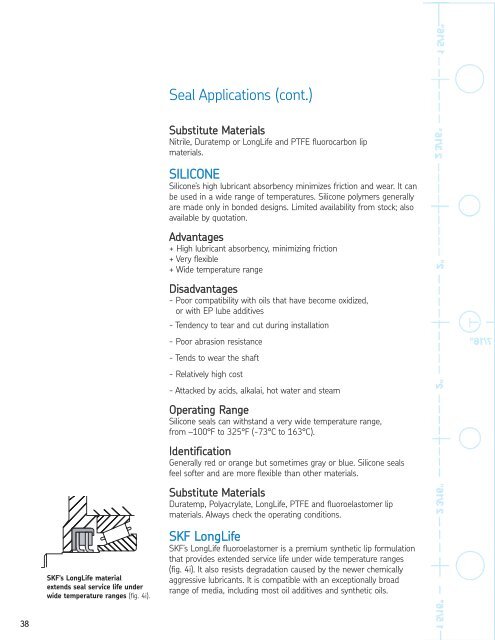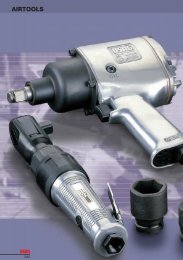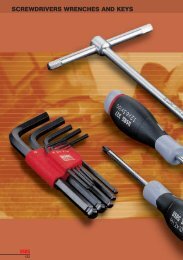Industrial seal self study guide - SKF.com
Industrial seal self study guide - SKF.com
Industrial seal self study guide - SKF.com
You also want an ePaper? Increase the reach of your titles
YUMPU automatically turns print PDFs into web optimized ePapers that Google loves.
Seal Applications (cont.)<br />
Substitute Materials<br />
Nitrile, Duratemp or LongLife and PTFE fluorocarbon lip<br />
materials.<br />
SILICONE<br />
Silicone’s high lubricant absorbency minimizes friction and wear. It can<br />
be used in a wide range of temperatures. Silicone polymers generally<br />
are made only in bonded designs. Limited availability from stock; also<br />
available by quotation.<br />
Advantages<br />
+ High lubricant absorbency, minimizing friction<br />
+ Very flexible<br />
+ Wide temperature range<br />
Disadvantages<br />
- Poor <strong>com</strong>patibility with oils that have be<strong>com</strong>e oxidized,<br />
or with EP lube additives<br />
- Tendency to tear and cut during installation<br />
- Poor abrasion resistance<br />
- Tends to wear the shaft<br />
- Relatively high cost<br />
- Attacked by acids, alkalai, hot water and steam<br />
Operating Range<br />
Silicone <strong>seal</strong>s can withstand a very wide temperature range,<br />
from –100°F to 325°F (-73°C to 163°C).<br />
Identification<br />
Generally red or orange but sometimes gray or blue. Silicone <strong>seal</strong>s<br />
feel softer and are more flexible than other materials.<br />
Substitute Materials<br />
Duratemp, Polyacrylate, LongLife, PTFE and fluoroelastomer lip<br />
materials. Always check the operating conditions.<br />
<strong>SKF</strong>’s LongLife material<br />
extends <strong>seal</strong> service life under<br />
wide temperature ranges (fig. 4i).<br />
<strong>SKF</strong> LongLife<br />
<strong>SKF</strong>’s LongLife fluoroelastomer is a premium synthetic lip formulation<br />
that provides extended service life under wide temperature ranges<br />
(fig. 4i). It also resists degradation caused by the newer chemically<br />
aggressive lubricants. It is <strong>com</strong>patible with an exceptionally broad<br />
range of media, including most oil additives and synthetic oils.<br />
38







